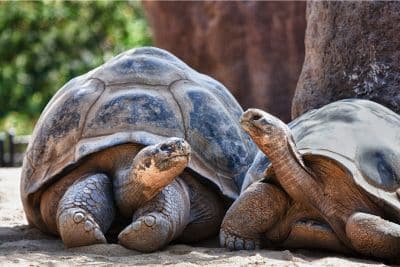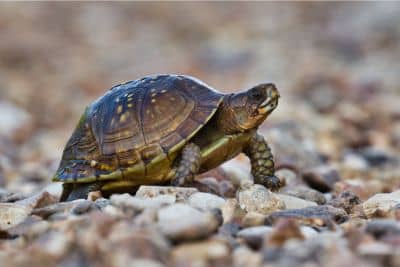Hermann’s tortoises (Testudo hermanni) are endearing animals, who’ve become quite popular with reptile keepers over the last several decades. But it is important for prospective keepers to note that there are two subspecies of the Hermann’s tortoise – the eastern Hermann’s tortoise (T. h. boettgeri) and the western Hermann’s tortoise (T. h. hermanni).
Both subspecies can make excellent pets, but most keepers working with this species tend to keep the eastern form. This is largely due to availability; eastern Hermann’s tortoises are more widely available in the pet trade than their western counterparts. However, some keepers simply prefer the eastern subspecies and opt for them even when provided with the chance to choose between the two.
In this article, I’ll share some of the key facts and stats about the eastern Hermann’s tortoise so that you can decide if one of these tortoises would make a good choice for your collection.
Geographic Range
While entire Hermann’s tortoise species lives across a large portion of southern Europe, stretching from Spain to Turkey, the eastern subspecies only occupies a portion of this range. In a nutshell, while the western subspecies inhabits portions of Spain, France, and Italy, the eastern subspecies is located entirely east of the Adriatic and Ionian Seas.
In total, the eastern Hermann’s tortoise inhabits some or all of the following countries:
- Serbia
- Kosovo
- North Macedonia
- Romania
- Bulgaria
- Albania
- Turkey
- Greece
- Bosnia and Herzegovina
- Croatia
- Montenegro
The habitat preferences of eastern Hermann’s tortoises largely mirror those of the eastern subspecies. They tend to prefer open habitats that provide ample basking opportunities. This includes rocky hillsides, meadows, grassy plains, and even open forests. These kinds of sun-bathed habitats also provide an abundance of food, further increasing their appeal.

Appearance and Physical Characteristics
While Hermann’s tortoises are quite variable, and even siblings can look quite different, there are a few relatively consistent differences between the two subspecies.
The most striking difference between individuals of the two subspecies is usually size. Western Hermann’s tortoises are quite small and rarely reach 7 inches in length. By contrast, many eastern Hermann’s tortoises eventually reach sizes in this range. And some grow much larger, with the largest individuals reaching or exceeding the 11-inch mark.
Sometimes, these two subspecies also present subtle differences in carapace shape. While most western Hermann’s tortoises have round shells, many eastern Hermann’s tortoises are described as being trapezoidal in shape when viewed from above.
Eastern and western Hermann’s tortoises also exhibit different head shapes. The western subspecies is generally said to have a “sculpted” or “elegant” head, which is typically light in colour and usually features a bright yellow subocular spot. Meanwhile, eastern Hermann’s tortoises tend to have blockier, rounder heads with very blunt snouts. Eastern individuals typically do not possess the yellow subocular spot that Eastern individuals do, though it may occasionally be present on hatchlings (until it fades).
There are also myriad differences between these two subspecies with regard to markings. While western Hermann’s tortoises are often considered the more attractive of the two forms, beauty is in the eye of the beholder, and plenty of keepers find eastern Hermann’s tortoises appealing.
Generally, western Hermann’s tortoises have highly contrasting, bold markings, which are more likely to have distinct borders. Eastern Hermann’s tortoises, on the other hand, are often clad in more diffuse markings, which don’t exhibit the sharp borders that Western individuals have. This trend continues onto the plastrons of these tortoises, with eastern Hermann’s tortoises typically having plaster washes that appear slightly smudged. This contrasts with the distinct black stripes western Hermann’s tortoises have on their plastrons.
There is also a striking difference between these two tortoises found on the fifth vertebral scute. In western Hermann’s tortoises, this cute bears a distinct mushroom- or keyhole-shaped marking. Eastern Hermann’s tortoises, on the other hand, rarely have such a distinct marking, and they often have no marking on this scute at all.
Diet
Both the diet of the eastern and western Hermann’s tortoise tend to be similar. They’re largely herbivorous, but they may consume invertebrates or carrion from time to time (this is neither necessary nor recommended in captivity). The bulk of their diet is comprised of high-fibre plants, including grasses, sedges, and weeds, but they also consume flowers and succulents.
Keepers are wise to provide captive Hermann’s tortoises with a diet that reflects the feeding habits of wild individuals.
Behaviour
Eastern and western Hermann’s tortoises tend to exhibit similar behavioural patterns In most respects. With that said some keepers have noticed differences that are worth considering when trying to choose which subspecies you’d prefer to keep.
- Eastern Hermann’s tortoises often hail from regions with longer, colder winters. This often leads them to hibernate for longer times than western Hermann’s tortoises do.
- Eastern Hermann’s tortoises are often considered the more active of the two subspecies. This, combined with their larger size, means that eastern Hermann’s tortoises typically require larger enclosures than western individuals.
- Eastern Hermann’s tortoises tend to suffer from stress more often than Western Hermann’s tortoises. This can present challenges for keepers, especially when maintaining wild-caught individuals.
- While eastern Hermann’s tortoises can be kept with other members of their own subspecies, they are more likely to display agonistic behaviours. Western Hermann’s tortoises, on the other hand, are more likely to get along well with cagemates.
Eastern Hermann’s Tortoise Stats at a Glance
At this point, you may have already decided that the eastern Hermann’s tortoise is the ideal pet for you. But if you haven’t, we’ll share some of the key stats for these animals to help you make your decision.
- Typical Hatchling Length: 1.5 to 2 inches
- Typical Hatchling Weight: 30 to 50 grams
- Average Adult Length: 6 to 7 inches
- Average Adult Weight: 4 to 5 pounds
- Maximum Adult Length: Approximately 11 inches
- Maximum Adult Weight: Approximately 9 pounds
- Average Annual Fecundity: 3 to 8 eggs, with some individuals producing multiple clutches
- Recommended Enclosure Size: 10 to 25 square feet of space
- Typical Lifespan: Unclear, but like most tortoises, many probably reach 50 years of age, and some may live for twice as long. At least two individuals are known to have reached ages in excess of 120 years, but it isn’t clear whether they were members of the eastern or western subspecies. In any event, both subspecies are undoubtedly capable of reaching advanced ages.
Citations
- The Links Road Animal & Bird Clinic — May 2023’s Animal Of The Month – Hermann’s Tortoises
- Hermanni Haven – Hermann’s Tortoise Subspecies
- Tortue d’Hermann — Morphology


